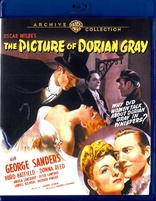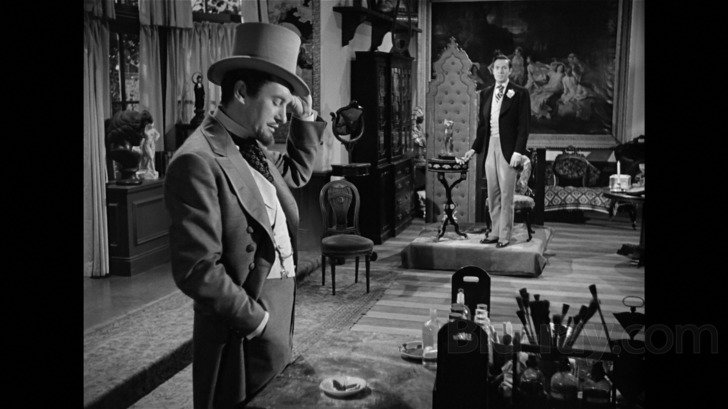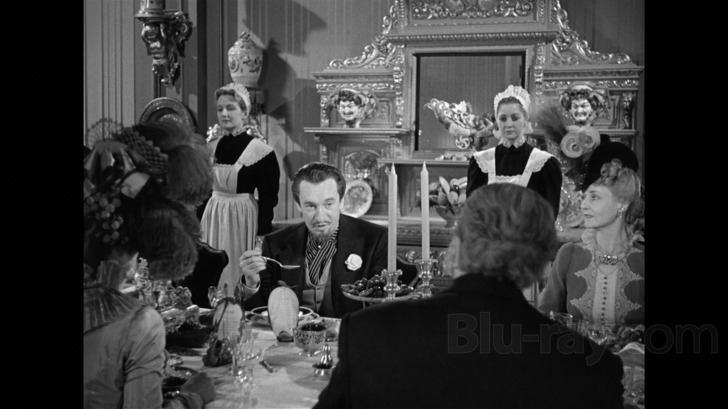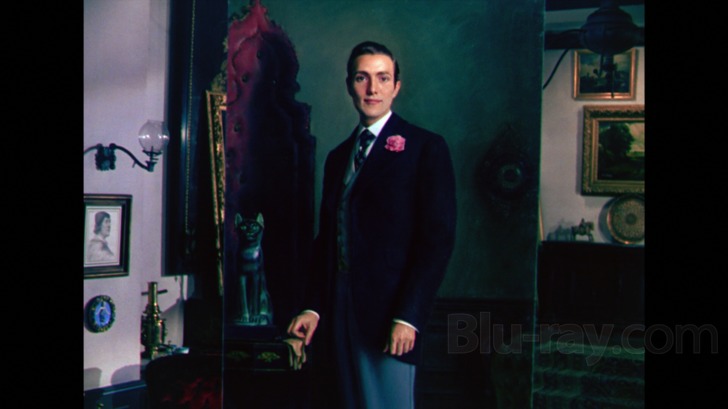The Picture of Dorian Gray Blu-ray Movie
HomeThe Picture of Dorian Gray Blu-ray Movie 
Warner Archive CollectionWarner Bros. | 1945 | 110 min | Not rated | Nov 18, 2014

Movie rating
7.5 | / 10 |
Blu-ray rating
| Users | 4.6 | |
| Reviewer | 4.5 | |
| Overall | 4.5 |
Overview
The Picture of Dorian Gray (1945)
In 1886, the dissolute Lord Henry Wotton meets Dorian Gray posing for talented painter Basil Hallward. Dorian wishes that his portrait could age instead of him. Over the years, as Lord Henry corrupts him, Dorian remains the same, while his friends age, but his picture discloses his evil life. Can he still have salvation or is his soul trapped in the doomed painting?
Starring: George Sanders (I), Hurd Hatfield, Donna Reed, Angela Lansbury, Peter LawfordNarrator: Cedric Hardwicke
Director: Albert Lewin
| Thriller | Uncertain |
| Drama | Uncertain |
| Fantasy | Uncertain |
| Romance | Uncertain |
| Horror | Uncertain |
Specifications
Video
Video codec: MPEG-4 AVC
Video resolution: 1080p
Aspect ratio: 1.37:1
Original aspect ratio: 1.37:1
Audio
English: DTS-HD Master Audio 2.0 Mono (48kHz, 24-bit)
Subtitles
English SDH
Discs
50GB Blu-ray Disc
Single disc (1 BD)
Playback
Region free
Review
Rating summary
| Movie | 4.5 | |
| Video | 4.5 | |
| Audio | 4.5 | |
| Extras | 3.0 | |
| Overall | 4.5 |
The Picture of Dorian Gray Blu-ray Movie Review
Seeing Your Self as Others Don't See You
Reviewed by Michael Reuben November 23, 2014"You must have a portrait in the attic!" is a compliment often delivered to a person aging gracefully, and it's generally understood even by people who have never read Oscar Wilde's novel The Picture of Dorian Gray or seen any of the film or TV adaptations. The notion of a picture that does all our aging for us, leaving the individual permanently young, is so universally tantalizing that it has become a cultural touchstone, entirely separate from Wilde's story. But Wilde had something more serious in mind. While Dorian Gray and his portrait are often compared to Dr. Jekyll and Mr. Hyde, there's an important difference. The two sides of one man's nature displayed in the much-adapted story by Robert Louis Stevenson exist simultaneously; indeed, they fight each other for control. For Oscar Wilde, there was only one Dorian Gray, but when that individual stepped outside of time, he was free to indulge all his worst instincts. The painting would suffer the consequences, but the man would remain unchanged and unaffected. By general consensus, the best film adaptation of Dorian Gray is the version released in 1945 by MGM, which was written and directed by Alfred Lewin, a prolific producer and occasional director. At MGM, he had been a protégé of the legendary Irving Thalberg, which gave him an extra measure of influence with studio head Louis B. Mayer, especially when a film went beyond schedule and over budget, both of which happened with Dorian Gray. Lewin was an exacting perfectionist in the mode of Stanley Kubrick or William Wyler, who could drive actors to distraction by insisting on as many as 130 takes. But Lewin understood how to adapt a classic work of literature like Dorian Gray for the screen. A scholar with degrees from NYU and Harvard, he changed only what was necessary for dramatic purposes and filled the frame with odd details, many of which register only subliminally, that convey the sense of moral corruption that made Wilde's novel so controversial when it was first serialized in 1890. As Wilde noted at the time in his own defense, he showed almost nothing of Dorian's bad behavior. Readers supplied it through their own guilty imaginings.

Dorian Gray (Hurd Hatfield) is a 22-year-old upperclass Englishman of independent means in Victorian London. His youthful good looks have inspired a portrait of uncommon vibrance by his friend, the painter Basil Hallward (Lowell Gilmore), whose niece, a little girl named Gladys, has a crush on Dorian and will grow up to be played by Donna Reed. As a little girl, however, she signs her initial to the portrait below her uncle's name. Many years later, that initial will turn out to be an important identifying mark. Another of the artist's friends, Lord Henry Wotton (George Sanders), stops by his studio for a visit on the afternoon when Basil completes the painting. Lord Henry is so struck by the portrait that he insists on meeting its subject. The indolent nobleman speaks in witty epigrams and aphorisms, much like the public image of Oscar Wilde, and although he is sought after as an entertaining dinner guest, his flouting of conventional morality is considered scandalous. Beneath the patter, though, Lord Henry is all talk. Much to the entertainment of Lord Henry, however, his new friend Dorian Gray takes the older man's philosophy of self-indulgence seriously to heart. As Dorian contemplates Basil's completed painting, he muses on the cruel irony that the painting will preserve his youthful appearance, while he grows old. Dorian wishes that it could be the opposite—a gift, he says, for which he would sell his soul. Here, the writer/director has introduced a small enhancement to Wilde's novel, a feline statue that occupies Basil Hallward's studio and is said to be an ancient Egyptian god, which somehow grants Dorian's wish. When Basil makes Dorian a gift of the painting, the statue accompanies it, and it seems to have a life of its own. Watch its position in the frame in Dorian's house, as it appears to shift between shots, silent and unobserved. These are not continuity errors; the cat is always watching the action, contemplating the course of events it has set in motion by granting Dorian's wish. As Dorian begins to explore Lord Henry's hedonistic approach to life, his first victim is an innocent young singer in an East End tavern, Sybil Vane, who is played by a young Angela Lansbury in a performance that was nominated for an Oscar and will be a revelation to anyone who knows Ms. Lansbury only from her later work in The Manchurian Candidate, on TV's Murder, She Wrote or as the original Mrs. Lovett in Sweeney Todd. Here, Lansbury is the soul of tremulous innocence so swept up by romantic illusion that she is deaf to the warnings of her brother, James (Richard Fraser), who cannot protect her because he is a seaman whose ship is about to depart. The name "Vane" is a leftover from the novel, where the character was more sophisticated, but writer/director Lewin cannily reconceived the character so that Dorian's casual mistreatment of Sybil would cast a shadow over the rest of the story. As in Wilde's novel, most of Dorian's misdeeds are left to the imagination, but after witnessing his cruel abuse of Sybil in Lansbury's captivating incarnation, we know he's capable of anything. The painting that ages in Dorian's place, and also reflects the evil that has infected his life, is rarely seen, especially after Dorian locks it securely in an abandoned upstairs room, away from public view. However, the portrait makes four key appearances as Technicolor inserts in this black-and-white film, and these eruptions of color add to the sense that Basil Hallward's creation has acquired a mystical existence beyond mere pigment and canvas. The first two appearances of color occur when the painting is new and then when it first alters in reaction to Dorian's cruelty to Sybil; the latter come many years later, after the painted figure no longer bears any resemblance to Basil Hallward's youthful model, although the painting's owner still looks like the unblemished youth of twenty-two that so inspired the artist. (The years between are bridged by the authoritative narration provided by Sir Cedric Hardwicke.) The problem for Dorian is that he cannot see himself as others see him. Unlike everyone else, he knows that his true self is the monster in the painting, and yet he can't bear to be away from the painting for long for fear that someone will discover it. His "bargain" has turned into a trap, depriving him of the enjoyment of youth and beauty for which he sold his soul. And like all such bargains, escape comes at a high price.
The Picture of Dorian Gray Blu-ray Movie, Video Quality 

Cinematographer Harry Stradling, Sr. won the first of two Oscars for the black-and-white cinematography of The Picture of Dorian Gray. (The second was for My Fair Lady in 1964.) Stradling's expressive use of shadow and his command of "deep focus" photography is essential to the design of writer/director Lewin's adaptation, which crowds the frame with figures, period detail and bizarre touches like the cat figure that keeps changing position and the man with the sandwich board advertisement who strolls along the sidewalk when Dorian first enters the establishment where he will meet Sybil Vane. (Watch the eye on the sandwich board.) The Warner Archive Collection's 1080p, AVC-encoded Blu-ray is yet another entry in its growing list of fine presentations of classic films. The blacks, whites and shades of gray are faithfully rendered with appropriate densities to yield a sharp and detailed image that does full justice to Stradling's expressive photography and the meticulously authentic sets on which director Lewin insisted. The four inserts of color photography are richly saturated, but WAC has wisely resisted any temptation to overdo the colors for modern tastes. The image reveals a fine and natural grain pattern undisturbed by untoward digital manipulation. As has been its usual custom, WAC has placed the 110-minute film on a BD-50 with a high average bitrate of 34.99 Mbps.
The Picture of Dorian Gray Blu-ray Movie, Audio Quality 

Dorian Gray's original mono soundtrack has been encoded on Blu-ray in lossless DTS-HD MA 2.0, with identical left and right channels. The source is in remarkably good shape, with no distortion or interference and very good dynamic range for its vintage. The dialogue is clear, and so are the vocal renditions by Angela Lansbury performing as Sybil Vane. The musical score by Herbert Stothart (an Oscar winner for The Wizard of Oz ) has the classical weight of an old Hollywood production and lends credibility to the story.
The Picture of Dorian Gray Blu-ray Movie, Special Features and Extras 

The extras have been ported over from Warner's 2008 DVD release of The Picture of Dorian Gray:
- Commentary with Angela Lansbury and Film Historian Steve Haberman: Haberman provides a wealth of detail about the making of Dorian Gray and the cast and crew responsible for it, while at the same time interviewing Lansbury, who was a new face in Hollywood when she made this film but was a respected veteran of stage and screen when she recorded this commentary. Having worked with many of her fellow cast members (e.g., Hurd Hatfield and George Sanders) on subsequent projects, Lansbury's sense of them as both actors and people is vivid and familiar, and she speaks of them with great affection. This is an essential commentary, both for fans of Dorian Gray and for anyone interested in how the old studio system worked.
- Stairway to Light (480i; 1.37:1; 10:22): This Oscar-winning short from 1945 recounts the history (more accurately, the legend) of 18th Century French physician Philippe Pinel, who is generally credited with revolutionizing the treatment of mental patients to shift the focus from confinement to treatment.
- Quiet Please! (480i; 1.37:1; 7:36): This Tom and Jerry cartoon about a dog who doesn't want his sleep disturbed by the antics of the battling cat and mouse won the Oscar for Best Short Subject, Cartoons, for 1945.
- Theatrical Trailer (480i; 1.37:1; 2:26): "The most unusual story to ever reach the screen!"
The Picture of Dorian Gray Blu-ray Movie, Overall Score and Recommendation 

The Picture of Dorian Gray is often described as a horror film, but I would characterize it more as a drama with a single supernatural device, namely the transference to the portrait from its subject. Once that central conceit is accepted, everything else flows logically from the character of Dorian Gray, as he falls under the influence of Lord Henry. Oscar Wilde's novel offered a metaphor for a life outside of time and free from the consequences of one's actions that has exerted a powerful hold on the popular imagination for over 120 years since its publication. WAC has given this memorable film adaptation an excellent presentation on Blu-ray. Highly recommended.
Similar titles
Similar titles you might also like

Bram Stoker's Dracula 4K
25th Anniversary Edition
1992

Footsteps in the Fog
1955

Dracula's Daughter 4K
1936

The China Syndrome
1979

Hangover Square
1945

Dr. Jekyll and Mr. Hyde
Warner Archive Collection
1941

Son of Dracula 4K
1943

Witness 4K
Standard Edition
1985

Gaslight
1944

Dracula 3D
2012

The Phantom of the Opera
Collector's Edition
1962

Great Expectations
1946

Dracula
Includes "Drácula"
1931

Taste the Blood of Dracula
1970

Kiss of the Damned
2012

Mary Reilly
1996

What Ever Happened to Baby Jane?
Warner Archive Collection
1962

Mad Love
Warner Archive Collection
1935

Byzantium
2012

The Lost Moment
1947